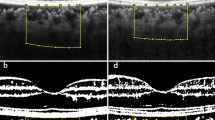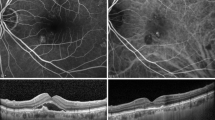Abstract
Purpose
The study was conducted to determine whether serum vascular endothelial growth factor (VEGF) levels are significantly correlated with subfoveal choroidal thickness (CT) and foveal thickness (FT) in patients with polyneuropathy, organomegaly, endocrinopathy, monoclonal gammopathy, and skin changes (POEMS) syndrome.
Patients and methods
In this cross-sectional observational case series, we studied 31 eyes of 16 treatment-naïve patients with POEMS syndrome with no evidence of fundus abnormalities. Subfoveal CT and FT were measured using enhanced depth imaging optical coherence tomography (EDI-OCT), and correlations between serum VEGF levels and subfoveal CT and FT were determined.
Results
The mean subfoveal CT was 417.9 ± 73.5 μm (right eye, 416.7 ± 81.2 μm; left eye, 419.0 ± 68.1 μm), and the mean FT was 243.8 ± 35.2 μm (right eye, 248.8 ± 22.0 μm; left eye, 239.1 ± 44.6 μm). There was a significant positive correlation between the serum VEGF level and subfoveal CT (right eye, r = 0.58, p = 0.021; left eye, r = 0.60, p = 0.012), but the correlation between the level of serum VEGF and FT was not significant (right eye, r = 0.007, p > 0.05; left eye, r = 0.25, p > 0.05).
Conclusions
The significant correlation between the serum VEGF level and subfoveal CT in patients with POEMS syndrome suggests that choroidal thickness is influenced by the level of serum VEGF. These results not only aid in an understanding of the pathogenesis of ocular changes in patients with POEMS syndrome, but also offer clues regarding the pathogenesis of other choroidal diseases.



Similar content being viewed by others
References
Bardwick PA, Zvaifler NJ, Gill GN, Newman D, Greenway GD, Resnick DL (1980) Plasma cell dyscrasia with polyneuropathy, organomegaly, endocrinopathy, M protein, and skin changes: the POEMS syndrome. Report on two cases and a review of the literature. Medicine 59:311–322
Dispenzieri A, Kyle RA, Lacy MQ, Rajkumar SV, Therneau TM, Larson DR, Greipp PR, Witzig TE, Basu R, Suarez GA, Fonseca R, Lust JA, Gertz MA (2003) POEMS syndrome: definitions and long-term outcome. Blood 101:2496–2506. doi:10.1182/blood-2002-07-2299
Watanabe O, Arimura K, Kitajima I, Osame M, Maruyama I (1996) Greatly raised vascular endothelial growth factor (VEGF) in POEMS syndrome. Lancet 347:702
Nakajima H, Ishida S, Furutama D, Sugino M, Kimura F, Yokote T, Baba I, Tsuji M, Hanafusa T (2007) Expression of vascular endothelial growth factor by plasma cells in the sclerotic bone lesion of a patient with POEMS syndrome. J Neurol 254:531–533. doi:10.1007/s00415-006-0268-y
Dispenzieri A (2007) POEMS syndrome. Blood Rev 21:285–299. doi:10.1016/j.blre.2007.07.004
Chong DY, Comer GM, Trobe JD (2007) Optic disc edema, cystoid macular edema, and elevated vascular endothelial growth factor in a patient with POEMS syndrome. J Neuroophthalmol : 180–183 DOI 10.1097/WNO.0b013e31814b2845
Bolling JP, Brazis PW (1990) Optic disk swelling with peripheral neuropathy, organomegaly, endocrinopathy, monoclonal gammopathy, and skin changes (POEMS syndrome). Am J Ophthalmol 109:503–510
Okada K, Yamamoto S, Tsuyama Y, Mizunoya S (2007) Case of POEMS syndrome associated with bilateral macular detachment resolved by autologous peripheral blood stem cell transplantation. Jpn J Ophthalmol 51:237–238. doi:10.1007/s10384-006-0428-8
Spaide RF, Koizumi H, Pozzoni MC (2008) Enhanced depth imaging spectral-domain optical coherence tomography. Am J Ophthalmol 146:496–500. doi:10.1016/j.ajo.2008.05.032
Margolis R, Spaide RF (2009) A pilot study of enhanced depth imaging optical coherence tomography of the choroid in normal eyes. Am J Ophthalmol 147:811–815. doi:10.1016/j.ajo.2008.12.008
Fujiwara A, Shiragami C, Shirakata Y, Manabe S, Izumibata S, Shiraga F (2012) Enhanced depth imaging spectral-domain optical coherence tomography of subfoveal choroidal thickness in normal Japanese eyes. Jpn J Ophthalmol 56:230–235. doi:10.1007/s10384-012-0128-5
Imamura Y, Fujiwara T, Margolis R, Spaide RF (2009) Enhanced depth imaging optical coherence tomography of the choroid in central serous chorioretinopathy. Retina 29:1469–1473. doi:10.1097/IAE.0b013e3181be0a83
Maruko I, Iida T, Sugano Y, Oyamada H, Sekiryu T, Fujiwara T, Spaide RF (2011) Subfoveal choroidal thickness after treatment of Vogt-Koyanagi-Harada disease. Retina 31:510–517. doi:10.1097/IAE.0b013e3181eef053
Fujiwara T, Imamura Y, Margolis R, Slakter JS, Spaide RF (2009) Enhanced depth imaging optical coherence tomography of the choroid in highly myopic eyes. Am J Ophthalmol 148:445–450. doi:10.1016/j.ajo.2009.04.029
Dhoot DS, Huo S, Yuan A, Xu D, Srivistava S, Ehlers JP, Traboulsi E, Kaiser PK (2013) Evaluation of choroidal thickness in retinitis pigmentosa using enhanced depth imaging optical coherence tomography. Bri J Ophthalmol 97:66–69. doi:10.1136/bjophthalmol-2012-301917
Yamada Y, Sawai S, Misawa S, Kanai K, Shibuya K, Mori M, Moriya J, Sogawa K, Yamamoto H, Beppu M, Taniguchi J, Nakaseko C, Nomura F, Kuwabara S (2013) Multiple angiogenetic factors are upregulated in POEMS syndrome. Ann Hematol 92:245–248. doi:10.1007/s00277-012-1583-2
Kaushik M, Pulido JS, Abreu R, Amselem L, Dispenzieri A (2011) Ocular findings in patients with polyneuropathy, organomegaly, endocrinopathy, monoclonal gammopathy, and skin changes syndrome. Ophthalmology 118:778–782. doi:10.1016/j.ophtha.2010.08.013
Ikuno Y, Tano Y (2009) Retinal and choroidal biometry in highly myopic eyes with spectral-domain optical coherence tomography. Invest Ophthalmol Vis Sci 50:3876–3880. doi:10.1167/iovs. 08-3325
Ding X, Li J, Zeng J, Ma W, Liu R, Li T, Yu S, Tang S (2011) Choroidal thickness in healthy Chinese subjects. Invest Ophthalmol Vis Sci 52:9555–9560. doi:10.1167/iovs. 11-8076
Wei WB, Xu L, Jonas JB, Shao L, Du KF, Wang S, Chen CX, Xu J, Wang YX, Zhou JQ, You QS (2013) Subfoveal choroidal thickness: the Beijing eye study. Ophthalmology 120:175–180. doi:10.1016/j.ophtha.2012.07.048
Hata M, Hirose F, Oishi A, Hirami Y, Kurimoto Y (2012) Changes in choroidal thickness and optical axial length accompanying intraocular pressure increase. Jpn J Ophthalmol 56:564–568. doi:10.1007/s10384-012-0173-0
Chakraborty R, Read SA, Collins MJ (2011) Diurnal variations in axial length, choroidal thickness, intraocular pressure, and ocular biometrics. Invest Ophthalmol Vis Sci 52:5121–5129. doi:10.1167/iovs. 11-7364
Lowe J, Araujo J, Yang J, Reich M, Oldendorp A, Shiu V, Quarmby V, Lowman H, Lien S, Gaudreault J, Maia M (2007) Ranibizumab inhibits multiple forms of biologically active vascular endothelial growth factor in vitro and in vivo. Exp Eye Res 85:425–430. doi:10.1016/j.exer.2007.05.008
Ferrara N, Damico L, Shams N, Lowman H, Kim R (2006) Development of ranibizumab, an anti-vascular endothelial growth factor antigen binding fragment, as therapy for neovascular age-related macular degeneration. Retina 26:859–870. doi:10.1097/01.iae.0000242842.14624.e7
Sekiguchi Y, Misawa S, Shibuya K, Nasu S, Mitsuma S, Iwai Y, Beppu M, Sawai S, Ito S, Hirano S, Nakaseko C, Kuwabara S (2013) Ambiguous effects of anti-VEGF monoclonal antibody (bevacizumab) for POEMS syndrome. J Neurol Neurosurg Psychiatry 84:1346–1348. doi:10.1136/jnnp-2012-304874
Imai H, Kusuhara S, Nakanishi Y, Teraoka Escano MF, Yamamoto H, Tsukahara Y, Negi A (2005) A case of POEMS syndrome with cystoid macular edema. Am J Ophthalmol 139:563–566. doi:10.1016/j.ajo.2004.09.016
Acknowledgments
The authors thank Professor Duco Hamasaki of the Bascom Palmer Eye Institute of the University of Miami for his critical discussion and final manuscript revision.
Conflict of interest
No conflicting relationship exists for any author.
Funding
None.
Author information
Authors and Affiliations
Corresponding author
Rights and permissions
About this article
Cite this article
Yokouchi, H., Baba, T., Misawa, S. et al. Correlation between serum level of vascular endothelial growth factor and subfoveal choroidal thickness in patients with POEMS syndrome. Graefes Arch Clin Exp Ophthalmol 253, 1641–1646 (2015). https://doi.org/10.1007/s00417-014-2843-8
Received:
Revised:
Accepted:
Published:
Issue Date:
DOI: https://doi.org/10.1007/s00417-014-2843-8




